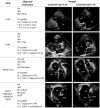Ebstein's anomaly in children and adults: multidisciplinary insights into imaging and therapy
- PMID: 37487694
- PMCID: PMC10850734
- DOI: 10.1136/heartjnl-2023-322420
Ebstein's anomaly in children and adults: multidisciplinary insights into imaging and therapy
Abstract
Although survival has significantly improved in the last four decades, the diagnosis of Ebstein's anomaly is still associated with a 20-fold increased risk of mortality, which generally drops after neonatal period and increases subtly thereafter. With increasing age of presentation, appropriate timing of intervention is challenged by a wide spectrum of disease and paucity of data on patient-tailored interventional strategies. The present review sought to shed light on the wide grey zone of post-neonatal Ebstein's manifestations, highlighting current gaps and achievements in knowledge for adequate risk assessment and appropriate therapeutic strategy.A 'wait-and-see' approach has been adopted in many circumstances, though its efficacy is now questioned by the awareness that Ebstein's anomaly is not a benign disease, even when asymptomatic. Moreover, older age at intervention showed a negative impact on post-surgical outcome.In order to tackle the extreme heterogeneity of Ebstein's anomaly, this review displays the multimodality imaging assessment necessary for a proper anatomical classification and the multidisciplinary approach needed for a comprehensive risk stratification and monitoring strategy. Currently available predictors of clinical outcome are summarised for both operated and unoperated patients, with the aim of supporting the decisional process on the choice of appropriate therapy and optimal timing for intervention.
Keywords: Arrhythmias, Cardiac; Congenital Abnormalities; Diagnostic Imaging; Genetics; Heart Defects, Congenital.
© Author(s) (or their employer(s)) 2024. Re-use permitted under CC BY-NC. No commercial re-use. See rights and permissions. Published by BMJ.
Conflict of interest statement
Competing interests: None declared.
Figures








References
-
- Anderson KR, Lie JT. The right ventricular myocardium in Ebstein’s anomaly: a morphometric histopathologic study. Mayo Clin Proc 1979;54:181–4. - PubMed
Publication types
MeSH terms
LinkOut - more resources
Full Text Sources
